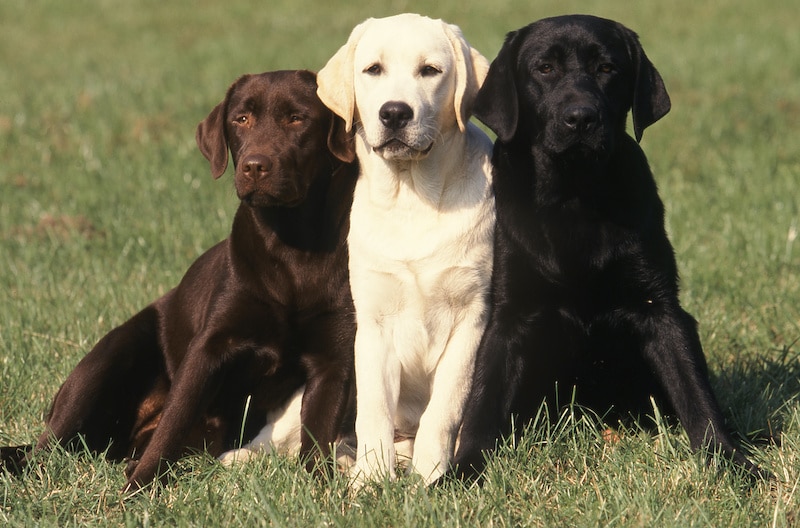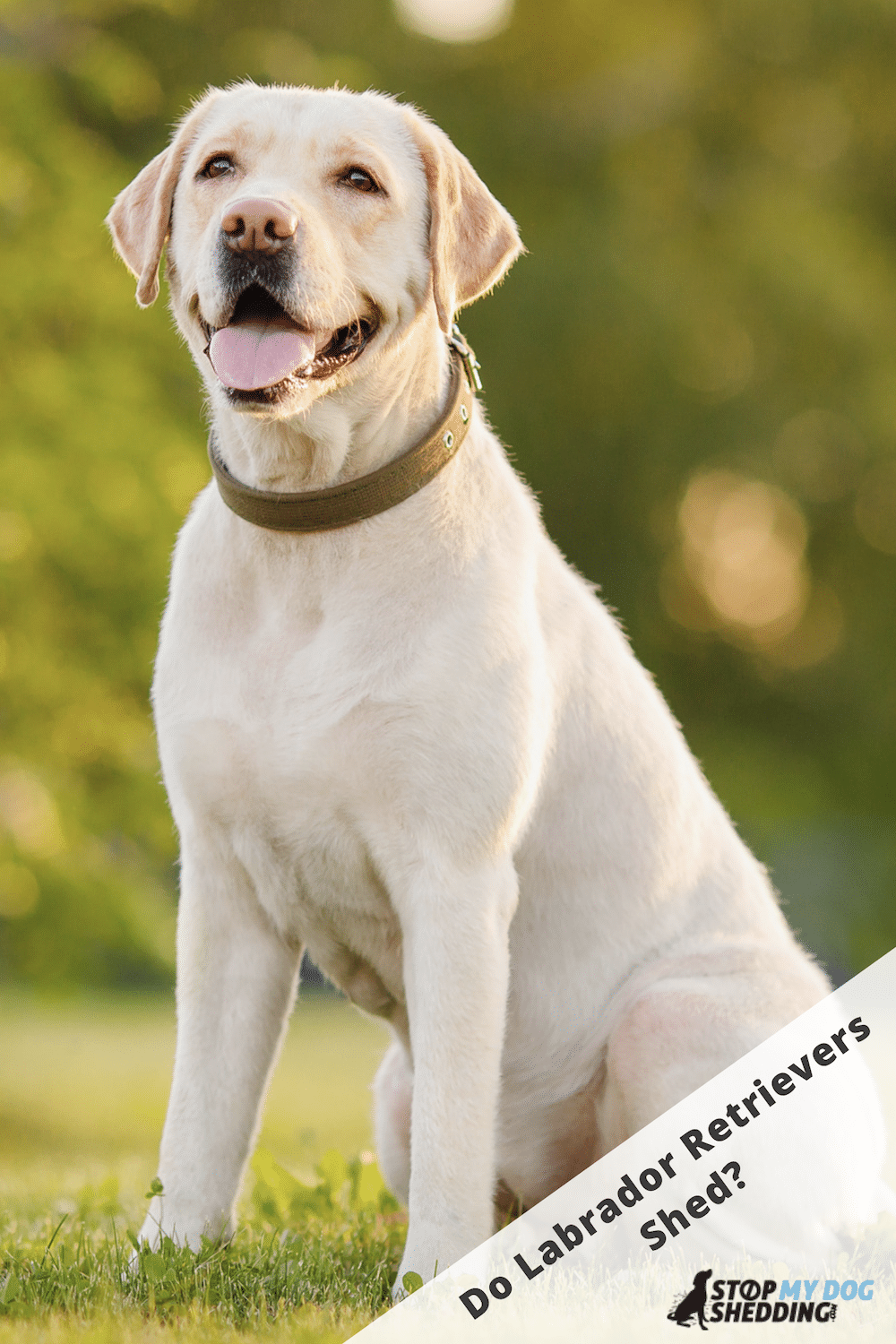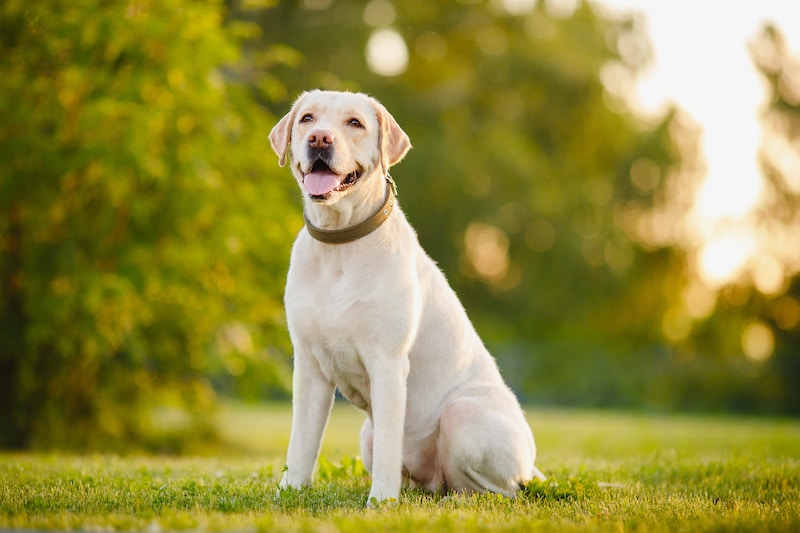Labrador Retrievers are friendly, outgoing dogs that originate from Newfoundland, where they were bred to help fisherman haul nets and retrieve fish from the freezing North Atlantic.
Today, they are the most popular dog breed in the United States. And it’s not hard to see why. Not only do Labs make great family companions, but they continue to excel as working dogs, most notably in guide, rescue, and detection work.
And yes, Labs do shed.
Labrador Retrievers have short, dense, water-resistant double coats that shed heavily year-round and more during shedding season in spring and fall. They’re fairly easy to groom, though, which is good news since brushing is one of the best ways to manage the shedding.
Read on to learn more about how much Labs shed, what they’re like to groom, and how to reduce the shedding, so you can keep your home as hair-free as possible.
Labrador Retriever Shedding – What to Expect
Labradors are a heavy shedding breed.
They tend to shed heavily year-round but are known to molt their undercoat twice per year, typically during spring and autumn.
This is known as seasonal shedding, and this is common among double-coated dogs. The reason they shed more heavily during this time is that they’re preparing for the change of season.
For example, during spring, they shed their thicker winter coat to prepare for the warmer months ahead, where their thicker coat is not needed.
The shedding isn’t as noticeable compared to dogs with thicker, longer coats, though. Like the Newfoundland or German Shepherd (AKA German Shedder), for example.
But you will typically notice hair falling out on a continual basis, and even more for a period of about 2-3 weeks during spring and fall.
Why do they shed so much?
There are a number of factors that can cause shedding (molting). But it mostly comes down to the dog breed, as well as things such as the time of year, their overall health, and the condition of their coat.
In some cases, excessive shedding can be cause for concern. Things like stress, poor diet, allergies, fleas, and other health-related problems can cause shedding. So if you have any concerns, it may be best to contact your veterinarian for assistance.
Shedding is normal among most healthy Labs, though. Even high levels of shedding. Many people think that short-coated dogs (like Labs) don’t shed much, but this simply isn’t the case.
There are plenty of dogs with short coats that molt lots. Like the Great Dane and Pug, for example. It’s just not normally as noticeable when it falls out as it is with a longer-haired dog.
In any case, the length of the coat does not determine how much fur they drop. It more comes down to the individual breed. And one common thread among breeds that shed heavily is that they have a shorter hair growth cycle. This means it takes less time for their fur to go through its natural cycle of growth (anagen), rest (catagen), and falling out (telogen).
Either way, Labs shed. But there are some things you can do to manage it, and grooming is one of them. Which, thankfully, isn’t very difficult.
Recommended: Go here to see our top-rated dog hair blow dryers
Grooming Your Labrador
Grooming a Labrador is fairly easy, they’re not high maintenance dogs by any means.
As cute and cuddly as they may be, they’re rugged working dogs at the core. So they don’t need endless amounts of brushing or professional grooming to maintain their coat.
The Labradors double coat is short, dense, and water-resistant. A double coat just means that they have two layers of fur instead of just one: a top coat and an undercoat.
Their top coat consists of short, straight, dense guard hairs that come in yellow, chocolate, or black. And their undercoat is soft and weather-resistant, which keeps them warm and dry.
Which is ideal given that they were bred to retrieve fish from freezing cold water. But it also helps to regulate their temperature during warmer weather too, so it doesn’t just protect them from the cold.
In any case, their coat is pretty easy to maintain.
Brush her two or three times a week with a slicker brush outside of shedding season. This should be enough to maintain her coat and remove most of the dead hair before it falls onto your floors, furniture, upholstery, and clothing.
A slicker brush is one of the most common types of dog brushes used in grooming. It is made up of fine wire bristles that are slightly angled and have rubber or plastic tips on the end to help protect their skin.
As an alternative, you could use a pin brush, rubber brush, or comb. Any of these can work well but at the same time, probably aren’t as effective as a slicker for removing the loose fur.
Either way, during shedding season, brushing with a de-shedding tool or undercoat rake can make your life easier. These are built to reach the undercoat and remove the old, dead fur as efficiently as possible. So they complement a slicker brush well during periods of heavy shedding.
Aside from brushing, bathe your Lab occasionally (every couple of months is a good general timeframe), using a good quality dog shampoo to help keep them clean.
Also, since they are water dogs, they love swimming!
And it helps to rinse them off in fresh water if they’ve been out for a swim, as this helps to ensure their skin and hair don’t dry out or get irritated.
As with all dogs, make sure you keep their nails trimmed, too, as long nails can cause pain while they’re walking or running around. And clean their teeth with proper toothpaste for dogs.
How to Stop Excessive Shedding (5 Methods)
It’s not possible to completely stop shedding, but you can reduce excessive amounts of shedding and learn how to manage it properly so that less fur ends up floating around your home.
Here’s how to reduce Labrador shedding:
- Brush your Lab regularly
- Bath him with a moisturizing dog shampoo
- Select a high-quality dog food that contains Omega-3
- Use a vacuum cleaner with a dog hair attachment
- Consult your veterinarian if the shedding is excessive
Now let’s explore each of these methods in more detail…
1. Brush your Lab regularly
Brushing is one of the simplest and most effective ways to manage shedding. And it’s not very difficult or time-consuming to do with a Lab since they’re so easy to brush.
Brush with a slicker brush and undercoat rake (or de-shedder) two or three times per week during shedding season. Not only will this remove the bulk of dead fur before it falls off of her coat, but it can help to distribute the skin oils, which in turn can lead to a healthier coat.
With that being said, it’s important not to overbrush and to be mindful of brushing more carefully around thinner parts of her coat, like the belly.
2. Bath him with a moisturizing dog shampoo
Bathing is another great way to minimize the shedding. Labs typically only need bathing once every couple of months, but bathing weekly during shedding season can help remove the dead fur.
Not only does bathing remove the old fur while they’re in the tub, but it helps loosen it up prior to a thorough brushing session. This is why this can be very effective when combined with brushing.
However, it is important to always use a good quality dog shampoo, and ideally one that moisturizes the skin. Never use low-quality or human shampoos, as these can dry out the skin and hair. Which is the same reason why it’s important not to over-bathe.
Dry skin and hair are among the top reasons why dogs shed excessively. So avoid doing anything that causes dryness and irritation.
3. Select a high-quality dog food that contains Omega-3
Generally speaking, the healthier your Labrador is, the better condition their coat will be in, and the less likely they are to shed excessively. And selecting the right dog food can have an impact on this.
Look for dog food that is made from high-quality ingredients and that contains the right amount of vitamins, minerals, and healthy fatty acids like Omega-3 and Omega-6.
There’s no special “anti-shedding dog food” out there, but some are better than others. So it’s worth speaking with your local veterinarian about selecting the right type of food for your dog.
There are also some worthwhile supplements that can help. There is no alternative to a healthy, balanced diet, but some Omega-3 supplements can make a difference.
4. Use a vacuum cleaner with a dog hair attachment
Once you’ve done everything possible to reduce the shedding, through regular grooming and proper nutrition, the best way to keep your home as fur-free as possible is with a vacuum that is specifically designed to clean up loose dog hair.
I personally use a Dyson (one designed for animals), but there are lots of great, less expensive options out there. The key is to find a vacuum with an attachment specifically designed to remove dog hair from carpet and upholstery.
The reason this can be so helpful is that Labradors have short, straight hairs that tend to needle their way into the carpet. And so it can take a LOT longer to vacuum without the right tools for the job.
Some companies even sell universal dog hair vacuum attachments on sites like Amazon that fit just about any vacuum. So you don’t need to spend lots of money on something fancy.
Granted, this isn’t a way to reduce shedding. But it is a way to limit how much time you spend cleaning it up, so it can be well worth looking into as a Lab owner.
5. Consult your veterinarian if the shedding is excessive
Even though shedding is common among Labs, sometimes it can be caused by things like stress, poor diet, allergies, fleas, and other health-related problems. And since Labs shed lots at the best of times, it can be difficult to determine if there’s an underlying problem or not.
This is why, if you have any concerns whatsoever, you should contact a qualified veterinarian. Your vet should be able to help you identify any potential issues and remedy them.
Related Questions
Are Labradors hypoallergenic?
No, Labs are not a hypoallergenic dog breed.
However, the truth is there are no 100% hypoallergenic dogs. There are just some dogs that are more suitable for allergy sufferers than others. And the reason for this is that all dogs produce things like dander (dead skin) which is mostly what causes pet-related allergies.
So, even if you have a hairless dog, it could trigger allergies. But so-called hypoallergenic dogs, like the Basenji or Poodle, for example, are generally considered more suitable for people with allergies than high shedding dogs that produce lots of dander, like Labs.
Do Yellow Labs shed more than Black Labs?
There is no evidence to suggest that the color of the Labrador’s coat makes a difference as to how much it sheds. Yellow, black, and chocolate colored Labs are ALL the same breed according to the American Kennel Club’s breed standard.

However, there are some people who believe it makes a difference. For example, here’s one comment from a person who says her yellow Lab sheds more than her black one:
“We’ve had two labs in the past one chocolate and a yellow and just got a black lab that is 8 weeks old. I can say that Maggie, our yellow shed way more hair then our chocolate, Bella ever did. It’s so strange how different they are like that. Our sweet puppy has a thicker coat and hasn’t started shedding yet.”
Comment from Dawn on labradortraininghq.com
There are similar comments online from others. But at the end of the day, this is anecdotal. And as mentioned earlier, there are a number of factors that can contribute to molting, besides just the breed itself.
Do Labradors shed more than Golden Retrievers?
Golden Retrievers shed a similar amount to Labrador Retrievers. But Goldens have longer hair, so grooming them does require more effort, especially since longer coats are more prone to mats and tangles.
What are some lower shedding alternative breeds?
If you’re looking for a lower shedding alternative to a Lab, there are lots of options. But to give you some relevant examples, lower shedding working dogs include breeds like the Standard Schnauzer or Portuguese Water Dog. Or, if you just want a low-shedding, easy-maintenance family dog, it’s hard to go past the Boston Terrier or Italian Greyhound.
There’s also a mixed breed called the Labradoodle which still molts, but not as much as a pure-bred Lab. It’s a mix between the Poodle (low shedding) and Labrador (high shedding).













Please note: By submitting a comment using the above comment form, you confirm that you agree with the storage and handling of your data by this site as detailed in our Privacy Policy.